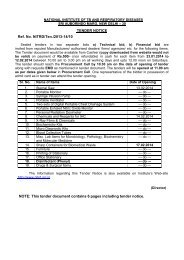October - LRS Institute of Tuberculosis & Respiratory Diseases
October - LRS Institute of Tuberculosis & Respiratory Diseases
October - LRS Institute of Tuberculosis & Respiratory Diseases
You also want an ePaper? Increase the reach of your titles
YUMPU automatically turns print PDFs into web optimized ePapers that Google loves.
GASTRIC TUBERCULOSIS ERODING SPLENIC ARTERY-AN UNUSUAL CASE OF HAEMETEMESIS 249<br />
vessels showed intimal fibrosis and tuberculous<br />
arteritis. Random sections from rest <strong>of</strong> the<br />
stomach revealed normal histology. Tubercle<br />
bacilli were demonstrated in histological sections<br />
with Ziehl Neelsen stain.<br />
Splenic Artery—identified on the superior<br />
border <strong>of</strong> pancreas was found lost in the space<br />
near splenic hi him (Fig. 1T1). Multiple histological<br />
sections through this space revealed an<br />
elastic structure (Splenic artery) infiltrated by<br />
exubcrent tuberculous inflammatory exudate.<br />
Fig. II-Gross photograph showing stomach (S) pulled<br />
apart and probe, passed through an ulcer,<br />
communicating with a space.<br />
Spleen—showed tuberculous granulomasand<br />
a large healed infarct (Fig. I), resulting from<br />
erosion and occlusion <strong>of</strong> splenic artery by a<br />
large thrombus.<br />
Liver—although grossly normal, showed<br />
granulomas both in lobults and portal tracts.<br />
Right lung—had an apical scar which on histology<br />
revealed marked fibrosis and occasional<br />
ill-formed granulomas. Hilar and tracheobronchia!<br />
lymph nodes showed calcification and<br />
occasional granuloma.<br />
Rest <strong>of</strong> the organs including intestines were<br />
found to be normal both grossly and microscopically.<br />
Fig. III-Gross photograph showing caseous lymph<br />
nodes (L), and splenic artery over superior border<br />
<strong>of</strong> pancreas (P) lost in the space near splenic<br />
hil urn.<br />
Fig. IV-Photomicrograph showing a granuloma<br />
gastric submucosa (H&E x 110).<br />
in<br />
Discussion<br />
Isolated case reports <strong>of</strong> primary gastric<br />
tuberculosis are available in the literature<br />
(Stirk 1968, Page et al 1975, Wani & Rashid<br />
1977, P. Sengupta 1978, Kakar et al 1979).<br />
It is almost always secondary to tuberculosis<br />
elsewhere in the body—pulmonary tuberculosis<br />
being held responsible in 50% <strong>of</strong> the cases<br />
(Henery Bockus, 1974). Our patient has had<br />
tuberculosis <strong>of</strong> right lung, with involvement <strong>of</strong><br />
hilar and tracheobronchial lymph nodes. The<br />
route by which the disease spread from the<br />
lungs to the stomach, pancreas, liver, spleen<br />
is, however, not absolutely clear. Three routes<br />
are possible: haematogenous; direct extension<br />
from neighbouring organs particularly caseating<br />
lymph nodes, and retrograde spread along lymphatics<br />
(Palmer 1950). It is likely that in our<br />
case the disease process spread haematogenously<br />
from lungs to stomach, spleen, pancreas and<br />
liver with subsequent involvement <strong>of</strong> draining<br />
lymph nodes (panereatosplenic). However, it is<br />
also possible that the disease spread through<br />
lymphatics from hilar and tracheobronchial<br />
lymphnodes to pancreatosplenic lymph nodes<br />
with subsequent afflication <strong>of</strong> stomach, spleen<br />
and pancreas. This however, fails to explain<br />
tuberculous lesion in the liver.<br />
Ind, J. Tub., Vol. XXIX, No. 4

















